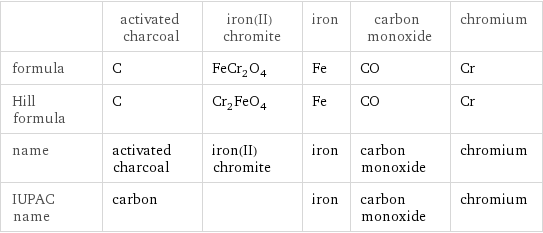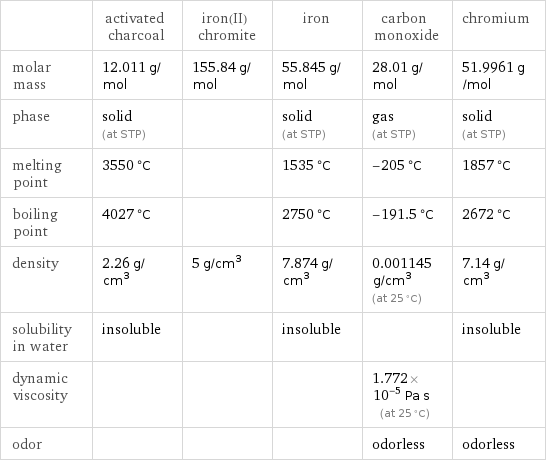Input interpretation

C activated charcoal + FeCr_2O_4 iron(II) chromite ⟶ Fe iron + CO carbon monoxide + Cr chromium
Balanced equation

Balance the chemical equation algebraically: C + FeCr_2O_4 ⟶ Fe + CO + Cr Add stoichiometric coefficients, c_i, to the reactants and products: c_1 C + c_2 FeCr_2O_4 ⟶ c_3 Fe + c_4 CO + c_5 Cr Set the number of atoms in the reactants equal to the number of atoms in the products for C, Cr, Fe and O: C: | c_1 = c_4 Cr: | c_2 = c_5 Fe: | c_2 = c_3 O: | 3 c_2 = c_4 Since the coefficients are relative quantities and underdetermined, choose a coefficient to set arbitrarily. To keep the coefficients small, the arbitrary value is ordinarily one. For instance, set c_2 = 1 and solve the system of equations for the remaining coefficients: c_1 = 3 c_2 = 1 c_3 = 1 c_4 = 3 c_5 = 1 Substitute the coefficients into the chemical reaction to obtain the balanced equation: Answer: | | 3 C + FeCr_2O_4 ⟶ Fe + 3 CO + Cr
Structures

+ ⟶ + +
Names

activated charcoal + iron(II) chromite ⟶ iron + carbon monoxide + chromium
Equilibrium constant
![Construct the equilibrium constant, K, expression for: C + FeCr_2O_4 ⟶ Fe + CO + Cr Plan: • Balance the chemical equation. • Determine the stoichiometric numbers. • Assemble the activity expression for each chemical species. • Use the activity expressions to build the equilibrium constant expression. Write the balanced chemical equation: 3 C + FeCr_2O_4 ⟶ Fe + 3 CO + Cr Assign stoichiometric numbers, ν_i, using the stoichiometric coefficients, c_i, from the balanced chemical equation in the following manner: ν_i = -c_i for reactants and ν_i = c_i for products: chemical species | c_i | ν_i C | 3 | -3 FeCr_2O_4 | 1 | -1 Fe | 1 | 1 CO | 3 | 3 Cr | 1 | 1 Assemble the activity expressions accounting for the state of matter and ν_i: chemical species | c_i | ν_i | activity expression C | 3 | -3 | ([C])^(-3) FeCr_2O_4 | 1 | -1 | ([FeCr2O4])^(-1) Fe | 1 | 1 | [Fe] CO | 3 | 3 | ([CO])^3 Cr | 1 | 1 | [Cr] The equilibrium constant symbol in the concentration basis is: K_c Mulitply the activity expressions to arrive at the K_c expression: Answer: | | K_c = ([C])^(-3) ([FeCr2O4])^(-1) [Fe] ([CO])^3 [Cr] = ([Fe] ([CO])^3 [Cr])/(([C])^3 [FeCr2O4])](../image_source/2a2efa05dda8d111129e51b0455302eb.png)
Construct the equilibrium constant, K, expression for: C + FeCr_2O_4 ⟶ Fe + CO + Cr Plan: • Balance the chemical equation. • Determine the stoichiometric numbers. • Assemble the activity expression for each chemical species. • Use the activity expressions to build the equilibrium constant expression. Write the balanced chemical equation: 3 C + FeCr_2O_4 ⟶ Fe + 3 CO + Cr Assign stoichiometric numbers, ν_i, using the stoichiometric coefficients, c_i, from the balanced chemical equation in the following manner: ν_i = -c_i for reactants and ν_i = c_i for products: chemical species | c_i | ν_i C | 3 | -3 FeCr_2O_4 | 1 | -1 Fe | 1 | 1 CO | 3 | 3 Cr | 1 | 1 Assemble the activity expressions accounting for the state of matter and ν_i: chemical species | c_i | ν_i | activity expression C | 3 | -3 | ([C])^(-3) FeCr_2O_4 | 1 | -1 | ([FeCr2O4])^(-1) Fe | 1 | 1 | [Fe] CO | 3 | 3 | ([CO])^3 Cr | 1 | 1 | [Cr] The equilibrium constant symbol in the concentration basis is: K_c Mulitply the activity expressions to arrive at the K_c expression: Answer: | | K_c = ([C])^(-3) ([FeCr2O4])^(-1) [Fe] ([CO])^3 [Cr] = ([Fe] ([CO])^3 [Cr])/(([C])^3 [FeCr2O4])
Rate of reaction
![Construct the rate of reaction expression for: C + FeCr_2O_4 ⟶ Fe + CO + Cr Plan: • Balance the chemical equation. • Determine the stoichiometric numbers. • Assemble the rate term for each chemical species. • Write the rate of reaction expression. Write the balanced chemical equation: 3 C + FeCr_2O_4 ⟶ Fe + 3 CO + Cr Assign stoichiometric numbers, ν_i, using the stoichiometric coefficients, c_i, from the balanced chemical equation in the following manner: ν_i = -c_i for reactants and ν_i = c_i for products: chemical species | c_i | ν_i C | 3 | -3 FeCr_2O_4 | 1 | -1 Fe | 1 | 1 CO | 3 | 3 Cr | 1 | 1 The rate term for each chemical species, B_i, is 1/ν_i(Δ[B_i])/(Δt) where [B_i] is the amount concentration and t is time: chemical species | c_i | ν_i | rate term C | 3 | -3 | -1/3 (Δ[C])/(Δt) FeCr_2O_4 | 1 | -1 | -(Δ[FeCr2O4])/(Δt) Fe | 1 | 1 | (Δ[Fe])/(Δt) CO | 3 | 3 | 1/3 (Δ[CO])/(Δt) Cr | 1 | 1 | (Δ[Cr])/(Δt) (for infinitesimal rate of change, replace Δ with d) Set the rate terms equal to each other to arrive at the rate expression: Answer: | | rate = -1/3 (Δ[C])/(Δt) = -(Δ[FeCr2O4])/(Δt) = (Δ[Fe])/(Δt) = 1/3 (Δ[CO])/(Δt) = (Δ[Cr])/(Δt) (assuming constant volume and no accumulation of intermediates or side products)](../image_source/1b6072c395b4c7544f0a29f590f6468f.png)
Construct the rate of reaction expression for: C + FeCr_2O_4 ⟶ Fe + CO + Cr Plan: • Balance the chemical equation. • Determine the stoichiometric numbers. • Assemble the rate term for each chemical species. • Write the rate of reaction expression. Write the balanced chemical equation: 3 C + FeCr_2O_4 ⟶ Fe + 3 CO + Cr Assign stoichiometric numbers, ν_i, using the stoichiometric coefficients, c_i, from the balanced chemical equation in the following manner: ν_i = -c_i for reactants and ν_i = c_i for products: chemical species | c_i | ν_i C | 3 | -3 FeCr_2O_4 | 1 | -1 Fe | 1 | 1 CO | 3 | 3 Cr | 1 | 1 The rate term for each chemical species, B_i, is 1/ν_i(Δ[B_i])/(Δt) where [B_i] is the amount concentration and t is time: chemical species | c_i | ν_i | rate term C | 3 | -3 | -1/3 (Δ[C])/(Δt) FeCr_2O_4 | 1 | -1 | -(Δ[FeCr2O4])/(Δt) Fe | 1 | 1 | (Δ[Fe])/(Δt) CO | 3 | 3 | 1/3 (Δ[CO])/(Δt) Cr | 1 | 1 | (Δ[Cr])/(Δt) (for infinitesimal rate of change, replace Δ with d) Set the rate terms equal to each other to arrive at the rate expression: Answer: | | rate = -1/3 (Δ[C])/(Δt) = -(Δ[FeCr2O4])/(Δt) = (Δ[Fe])/(Δt) = 1/3 (Δ[CO])/(Δt) = (Δ[Cr])/(Δt) (assuming constant volume and no accumulation of intermediates or side products)
Chemical names and formulas

| activated charcoal | iron(II) chromite | iron | carbon monoxide | chromium formula | C | FeCr_2O_4 | Fe | CO | Cr Hill formula | C | Cr_2FeO_4 | Fe | CO | Cr name | activated charcoal | iron(II) chromite | iron | carbon monoxide | chromium IUPAC name | carbon | | iron | carbon monoxide | chromium
Substance properties

| activated charcoal | iron(II) chromite | iron | carbon monoxide | chromium molar mass | 12.011 g/mol | 155.84 g/mol | 55.845 g/mol | 28.01 g/mol | 51.9961 g/mol phase | solid (at STP) | | solid (at STP) | gas (at STP) | solid (at STP) melting point | 3550 °C | | 1535 °C | -205 °C | 1857 °C boiling point | 4027 °C | | 2750 °C | -191.5 °C | 2672 °C density | 2.26 g/cm^3 | 5 g/cm^3 | 7.874 g/cm^3 | 0.001145 g/cm^3 (at 25 °C) | 7.14 g/cm^3 solubility in water | insoluble | | insoluble | | insoluble dynamic viscosity | | | | 1.772×10^-5 Pa s (at 25 °C) | odor | | | | odorless | odorless
Units
